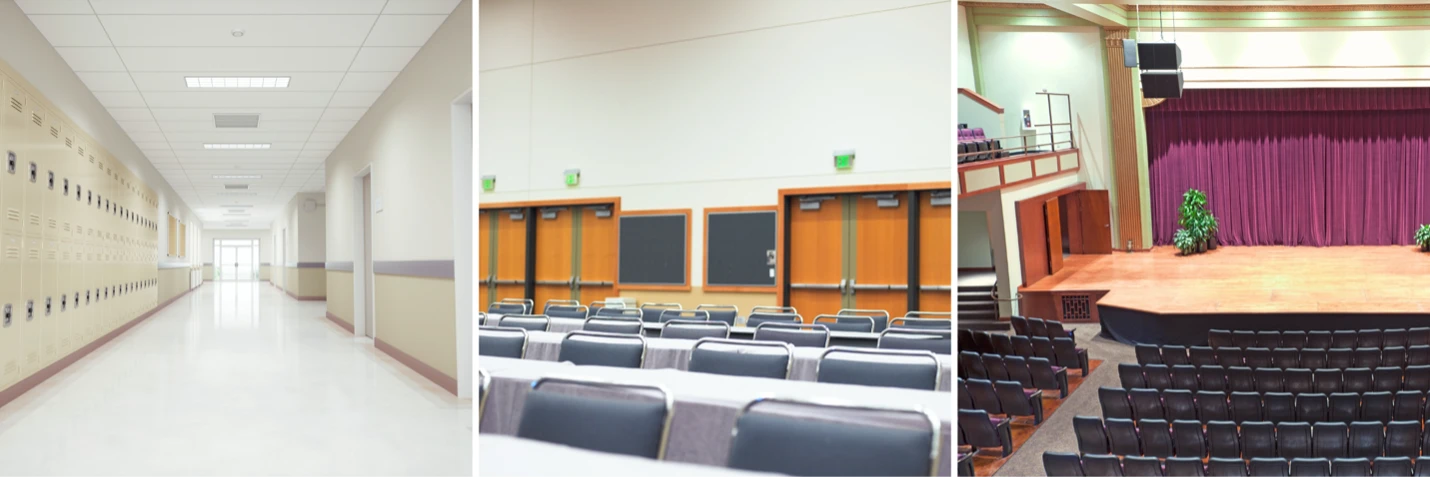
Creating an effective learning environment in schools involves more than a well-structured curriculum and experienced teachers. The physical environment, particularly the acoustics, plays a crucial role in facilitating or hindering the learning process. Independent laboratory-tested acoustic door assemblies, such as those offered by industry leaders, are essential in managing sound transmission within educational facilities, ensuring they are conducive to both teaching and learning.
This blog explores the significance of acoustic door assemblies in schools, explaining what they are and how they function. It highlights how they create effective learning environments, provide designated spaces for noisy activities, enhance the well-being of students and teachers, and discusses STC (Sound Transmission Class) ratings relevant to school projects.

Understanding Acoustic Door Assemblies
Acoustic door assemblies are systems designed to minimize sound transmission between spaces, making them critical in noise-sensitive environments like schools. These assemblies typically include:
- Doors made from dense materials to block and absorb sound.
- Frames that ensure a tight seal around the door.
- Perimeter seals and door bottoms to close gaps.
- Thresholds that work with door bottoms for a complete seal.
- Astragals for double doors to cover door openings.
- Specialized glass for sidelights and door vision lites.
Together, these components create an effective barrier that significantly reduces sound transmission, ensuring quieter, more focused learning environments.
Creating Effective Learning Environments
One of the primary benefits of acoustic door and frame assemblies is their ability to create quiet, distraction-free classrooms. Excessive noise levels can negatively impact students’ academic performance and their ability to concentrate. According to the Acoustical Society of America, students in quieter classrooms scored significantly higher on standardized tests compared to those in noisier environments. By minimizing external noise and preventing sound from leaking into adjacent rooms, these acoustic doors help maintain an environment where students can focus better and absorb information more effectively.

Additionally, quieter learning environments are particularly beneficial for students with special needs. Research indicates that children with learning difficulties, such as those with ADHD or auditory processing disorders, are more sensitive to background noise, which can further impair their ability to concentrate and comprehend lessons. Ensuring that classrooms are equipped with high-performance acoustic door assemblies can significantly enhance the learning experience for these students by reducing auditory distractions.
Designated Spaces for Noisy Activities
Schools cater to a variety of activities, some of which are inherently noisy. Band and practice rooms, music halls, and auditoriums are essential for the development of students’ artistic and creative skills. However, without proper sound management, the noise from these spaces can disrupt other classes. Acoustic doors and frames effectively contain sound within these designated areas, ensuring that music and other loud activities do not interfere with academic sessions in nearby classrooms and that noise from busy corridors does not disrupt activities in these areas.

Health Implications
The benefits of acoustic door and frame assemblies extend beyond academic performance to encompass the health and well-being of students and teachers. Prolonged exposure to high noise levels can lead to increased stress, fatigue, and even hearing loss. According to the World Health Organization, noise pollution is a significant environmental health threat that can cause a range of health problems, including cardiovascular issues and cognitive impairment in children. By effectively mitigating noise pollution within schools, the use of certified acoustic door and frame assemblies contributes to a healthier and more comfortable environment.
For teachers, managing classroom noise is crucial for maintaining their vocal health. Teachers often need to speak loudly to overcome background noise, which can lead to vocal strain and long-term damage. Designs that include adequate acoustic abatement, including the use of acoustic door and frame assemblies, help create quieter classrooms. This allows teachers to communicate more effectively without raising their voices, thereby protecting their vocal health and improving overall classroom communication, as highlighted by the American Speech-Language-Hearing Association.
Enhanced Environment for Teachers
An effective learning environment is not only beneficial for students but also for teachers. Teachers need to hold students’ attention for extended periods, and a noisy classroom can make this task significantly more challenging. Acoustic door assemblies help maintain an optimal acoustic environment, which aids teachers in managing their classrooms better and delivering lessons more efficiently.
In quieter classrooms, teachers can engage with students more effectively, use a wider range of teaching strategies, and create an interactive learning atmosphere. The reduction in background noise also minimizes the cognitive load on students, making it easier for them to follow instructions and participate in discussions, as noted by the Acoustical Society of America.

Understanding STC Ratings
The effectiveness of acoustic door assemblies is measured using Sound Transmission Class (STC) ratings. STC ratings quantify how well a door assembly can reduce sound transmission between spaces. The higher the STC rating, the better the noise abatement.
In school environments, different spaces require different STC ratings based on their use. For example:
- Classrooms and Offices: STC ratings of 35-45 are generally sufficient to ensure that normal speech and classroom activities do not disturb adjacent rooms and that corridor noise does not interrupt classroom activities.
- Music Rooms and Band Halls: These areas require higher STC ratings, typically between STC 50 to STC 55, to contain the loud sounds produced by musical instruments.
- Auditoriums and Theaters: Similar to music rooms, these spaces benefit from high STC ratings (50+) to ensure that performances do not interfere with other activities within the school.

Conclusion
Acoustic door assemblies and frames are a critical element in designing effective school environments. They help create quiet classrooms conducive to learning, provide designated spaces for noisy activities without disrupting other classes, improve the health and well-being of students and teachers, and support teachers in maintaining attention and communication with their students. Understanding the appropriate STC ratings for different school environments ensures that the acoustic needs of each space are met, contributing to the overall educational experience.
By investing in high-quality acoustic door assemblies from industry leaders, schools can enhance the learning environment, support student success, and promote the well-being of their entire educational community. As an industry leader in the development and manufacture of various types of swinging and sliding acoustic door assemblies, AMBICO offers solutions for all applications within the built environment, and our staff is readily available to consult on all of your acoustic door assembly needs.




